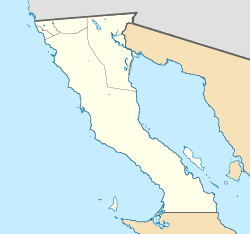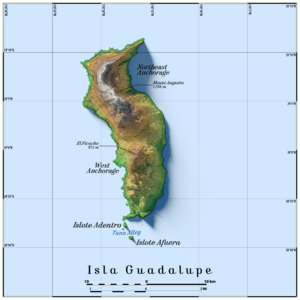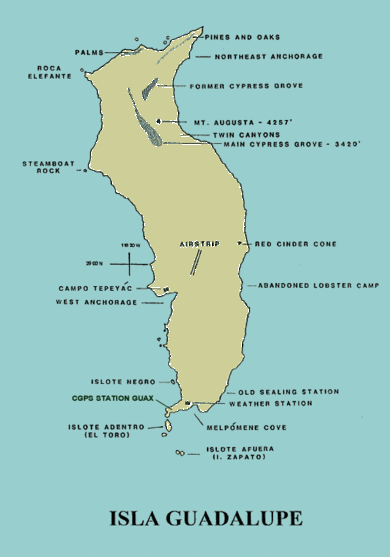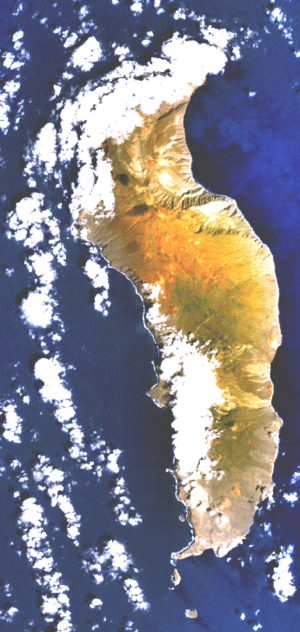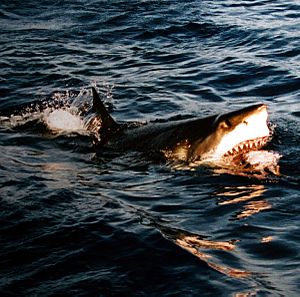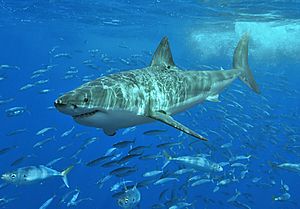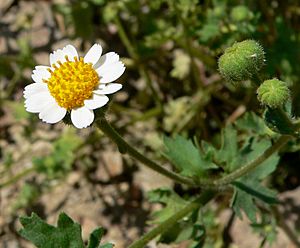Guadalupe Island facts for kids
|
Isla Guadalupe
|
|
|---|---|
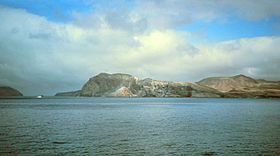
Southeastern coast of Guadalupe Island
|
|
|
Map of Guadalupe Island, Mexico
|
|
| Geography | |
| Location | Pacific Ocean |
| Coordinates | 29°1′51″N 118°16′48″W / 29.03083°N 118.28000°W |
| Area | 243.988 km2 (94.204 sq mi) |
| Highest elevation | 4,257 ft (1,297.5 m) |
| Highest point | Mount Augusta |
| Administration | |
|
Mexico
|
|
| State | Baja California |
| Municipality | Ensenada |
| Delegación | Ensenada |
| Demographics | |
| Population | 213 (2010) |
| Additional information | |
| Official language: Spanish | |
Guadalupe Island (Spanish: Isla Guadalupe) is a volcanic island in the Pacific Ocean. It's located about 241 kilometers (150 miles) off the western coast of Mexico's Baja California Peninsula. The island is part of the state of Baja California.
The volcanoes on Guadalupe Island are no longer active. In 2005, the island and its nearby waters became a biosphere reserve. This means it's a special protected area. The goal is to help the plants grow back and protect the amazing marine animals and birds that live there.
Guadalupe Island is a famous spot for seeing great white sharks. People used to go there for shark cage diving. Only scientists, military staff, and a few seasonal fishermen live on the island. The island is mostly dry and doesn't have much fresh water on its surface.
Guadalupe Island and its small islets are the westernmost part of Mexico. This means they are the furthest west point in the country.
Contents
Island History
The first time Guadalupe Island was seen by Europeans was in 1602. A Spanish expedition led by Sebastián Vizcaíno sailed past it. They did not land on the island.
In the late 1700s and 1800s, people often visited the island. They were hunting fur seals, otters, and elephant seals. Wild goats were probably brought to the island by seal hunters in the early 1800s. These goats quickly grew in number. They ate almost all the native plants on the island.
Who Lives on Guadalupe Island?
In 2010, a count showed 213 people living on the island. By 2015, it was thought that fewer than 150 people lived there permanently. Guadalupe Island is part of the Ensenada area. This area is one of the subdivisions of the Ensenada Municipality in Mexico.
Campo Oeste ("West Camp") is a small village for fishermen. They catch abalone and lobster. This camp is on the western coast of the island. It has about 15 buildings. Strong winds and waves hit the island in winter, but this bay offers protection.
Generators provide electricity for the camp. A military ship brings fresh water to the island. The number of fishermen changes each year. It depends on the fishing season. About 30 families from a fishing group live there for ten months of the year.
There are also a few other temporary fishing camps. These include Campo Norte ("North Camp"), Campo Lima, and Arroyitos.
At the very south of the island, there is a weather station. Mexican Navy staff work there. This place is called Campamento Sur ("South Encampment").
Campo Bosque was set up in 1999. It is in the cypress forest in the north. People from a farming society live here. They help remove wild goats from the island. They sell the goats in the state of Sonora. This is done with permission from the Mexican government.
Campo Pista is located at the island's small airport. The airport has a 1,200-meter (3,900-foot) long runway. You can see the remains of an old plane near one end of the runway. It crashed when it landed. Another old bomber plane also crashed there. Its wreckage was removed between 2005 and 2006.
Because Guadalupe Island is a protected biosphere reserve, you need special permission to visit. This means the communities on the island are like closed towns.
Island Geology
Guadalupe Island has a rough and rocky landscape. It is made of two shield volcanoes. These volcanoes formed on a mid-ocean ridge that is now inactive. The island is covered by old lava flows and small volcanoes. These formed from cracks in the earth.
The newest volcano is at the northern end of the island. It might have formed in the Holocene epoch. The newest rocks on Guadalupe Island are fresh-looking lava flows. They are found in the northern volcano's main crater.
Island Geography
The island is about 35 kilometers (22 miles) long from north to south. It is up to 9.5 kilometers (6 miles) wide from east to west. Its total area is about 244 square kilometers (94 square miles). The island has a chain of high volcanic mountains. The highest point is Mount Augusta, which is 1,298 meters (4,257 feet) tall. In the south, the smaller El Picacho is 975 meters (3,199 feet) tall.
The southern part of the island is mostly bare. But there are some trees in the higher parts of the north. There are also trees in the Twin Canyon area on the northeast coast. The coast is mostly rocky cliffs. There are some small rocks in front of them.
Two tall, noticeable islets are near the southwest end of the island. They are separated by a gap called Tuna Alley:
- Islote Afuera (Outer Islet) is the furthest away. It is steep with almost vertical walls.
- Islote Adentro (Inner Islet) is closer. It has two smaller islets nearby:
- Church Rock
- Roca del Skip
Other islets around the island are very small. They are close to the shore. All are less than 1 kilometer (0.6 miles) away:
- Islote Negro to the southwest.
- Roca Hundida to the southwest.
- Islote Bernal to the southwest.
- Palto Muerto north of Islote Bernal.
- An unnamed islet north of Islote Bernal.
- Steamboat Rock to the west.
- Roca Elefante to the northwest. This is the westernmost point of both Mexico and Latin America.
Island Climate
The island has two main climate zones. Below 800 meters (2,600 feet), it is very dry and warm. The average monthly temperature is between 15.5 and 20.3°C (60 and 68.5°F). Above 800 meters, it is dry and mild.
Most of the rain falls during the winter months. Strong northwestern winds and storms bring this rain.
Rainfall averages about 133 millimeters (5.2 inches) near sea level in the south. But it seems to rain much more in the high northern part. The Pinus radiata (Monterey pine) trees grow there. These trees usually need about 750 millimeters (30 inches) of rain. They can survive with half that amount. The moisture is also higher because of fog drip (water from fog).
| Month | Jan | Feb | Mar | Apr | May | Jun | Jul | Aug | Sep | Oct | Nov | Dec | Year |
|---|---|---|---|---|---|---|---|---|---|---|---|---|---|
| Record high °C (°F) | 27.8 (82.0) |
30.0 (86.0) |
30.0 (86.0) |
28.4 (83.1) |
29.5 (85.1) |
31.3 (88.3) |
31.7 (89.1) |
35.0 (95.0) |
32.2 (90.0) |
32.2 (90.0) |
30.6 (87.1) |
28.8 (83.8) |
35.0 (95.0) |
| Mean daily maximum °C (°F) | 18.9 (66.0) |
19.6 (67.3) |
19.8 (67.6) |
20.1 (68.2) |
20.8 (69.4) |
21.8 (71.2) |
23.0 (73.4) |
23.9 (75.0) |
24.2 (75.6) |
23.2 (73.8) |
21.6 (70.9) |
20.1 (68.2) |
21.4 (70.5) |
| Daily mean °C (°F) | 15.5 (59.9) |
15.6 (60.1) |
15.6 (60.1) |
16.1 (61.0) |
16.7 (62.1) |
17.6 (63.7) |
19.0 (66.2) |
20.1 (68.2) |
20.3 (68.5) |
19.4 (66.9) |
17.9 (64.2) |
16.3 (61.3) |
17.5 (63.5) |
| Mean daily minimum °C (°F) | 11.8 (53.2) |
11.6 (52.9) |
11.6 (52.9) |
12.0 (53.6) |
12.4 (54.3) |
13.1 (55.6) |
14.5 (58.1) |
15.9 (60.6) |
16.4 (61.5) |
15.5 (59.9) |
13.8 (56.8) |
12.5 (54.5) |
13.4 (56.1) |
| Record low °C (°F) | 3.5 (38.3) |
3.4 (38.1) |
2.2 (36.0) |
1.0 (33.8) |
6.2 (43.2) |
7.6 (45.7) |
8.0 (46.4) |
8.8 (47.8) |
5.4 (41.7) |
6.2 (43.2) |
4.5 (40.1) |
0.9 (33.6) |
0.9 (33.6) |
| Average precipitation mm (inches) | 16.3 (0.64) |
21.6 (0.85) |
18.0 (0.71) |
9.5 (0.37) |
1.1 (0.04) |
1.2 (0.05) |
0.4 (0.02) |
0.2 (0.01) |
0.6 (0.02) |
5.1 (0.20) |
12.3 (0.48) |
22.2 (0.87) |
108.5 (4.27) |
| Average precipitation days (≥ 0.1 mm) | 2.16 | 2.00 | 2.55 | 1.10 | 0.37 | 0.14 | 0.12 | 0.07 | 0.17 | 0.82 | 1.89 | 2.32 | 13.71 |
| Average relative humidity (%) | 79 | 79 | 78 | 78 | 79 | 82 | 83 | 81 | 81 | 80 | 79 | 79 | 80 |
| Source: Colegio de Postgraduados | |||||||||||||
Island Wildlife and Conservation
- Further information: Guadalupe Island Biosphere Reserve
Guadalupe Island was a popular spot for fur hunters in the 1700s and 1800s. They hunted the Guadalupe fur seal (Arctocephalus townsendi). They also hunted the northern elephant seal (Mirounga angustirostris) for its oil.
People thought northern elephant seals were extinct by 1884. But in 1892, a small group of eight was found on Guadalupe Island. The Mexican government finally protected these seals in 1922.
Guadalupe Island is similar to the Channel Islands of California in its plant life. However, the island's plants were almost completely eaten by up to 100,000 feral goats. These wild goats were brought to the island in the 1800s by sailors. They were meant to be food. But their population grew too large.
A naturalist named A. W. Anthony wrote in 1901 that the goats caused many interesting plant species to disappear. They also caused some birds unique to the island to vanish.
After a big drop in their numbers, the wild goat population grew again. In 2002, the Mexican government and a conservation group started removing the goats. By 2007, about 10,000 wild goats had been removed. Guadalupe Island became a protected biosphere nature reserve in 2005.
In 1827, a French sea captain noticed tall trees on the north of Guadalupe Island. There were four main tree species: the Guadalupe palm, Guadalupe cypress, island oak, and Monterey pine. Only old trees were left because the goats ate all the young seedlings. The California juniper trees disappeared completely.
Water was once plentiful from fog condensing in the forests. Now, it's only found in a few pools and springs. Since 2000, fences have been built to keep goats away from these water sources. This has allowed new seedlings to grow for the first time in 150 years. A group called Seacology helped fund these fences.
Many sea animals and plants found near Guadalupe Island also live near the Channel Islands. Guadalupe Island was the last safe place for the northern elephant seal and the Guadalupe fur seal in the 1890s. The island has been a protected area for seals and sea lions since 1975.
Cool, nutrient-rich ocean currents help tiny ocean plants grow. These plants attract many sea creatures. This includes Spanish mackerel, yellowfin tuna, and great white sharks.
Guadalupe is known as one of the best places in the world to see great white sharks. This is because the water is clear, and there are many seals and sea lions, which are the sharks' main food. Over 350 identified white sharks gather here. This made the island a popular spot for shark cage diving.
However, in 2019, the Mexican government stopped shark cage diving and sport fishing. This was to study how tourism affected the protected white sharks. As of January 10, 2023, shark cage diving at Isla Guadalupe is permanently not allowed. The Mexican government's ban covers all tourism inside the reserve. This includes filming and liveaboard diving.
The island is also recognized as an Important Bird Area (IBA). This means it's a very important place for birds.
Island Habitats
Before the wild goats were removed, studies found eight main land habitats on Guadalupe:
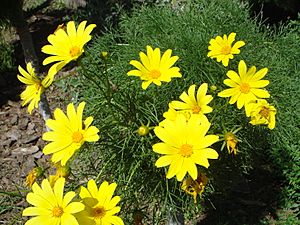
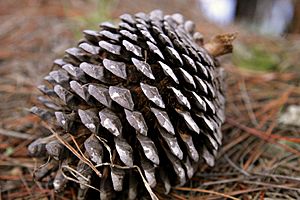
- Coastal Lowlands and Rocky Cliffs: This area is up to 200 meters (650 feet) above sea level. It's hard to study because of the steep cliffs.
- Succulent Plants: These are found between 200 and 400 meters (650-1,300 feet) above sea level. They are mostly on the southern end and small offshore islets. Many unique plants live here.
- Dry Maritime Shrubland: This habitat is between 400 and 600 meters (1,300-2,000 feet) above sea level. It's mainly in the southern part around El Picacho.
- Herbland with Introduced Plants: This area is between 600 and 800 meters (2,000-2,600 feet) above sea level. It's mostly on the central plateau. This habitat changed a lot because of overgrazing by goats.
- Guadalupe Palm Groves: These are found between 400 and 900 meters (1,300-3,000 feet) above sea level. They are on the northwest side of the island. Hundreds of palm trees remain, mostly in one large group.
- Guadalupe Cypress Forest: This forest is between 800 and 1,000 meters (2,600-3,300 feet) above sea level. There are about 4,000 old trees. They are mostly in the central-northern part. Other cypress forests were destroyed by goats.
- Guadalupe Palm, Island Oak, and Monterey Pine Woodland: This habitat is between 900 and 1,000 meters (3,000-3,300 feet) above sea level. It has almost disappeared in the last century. This is because the number of oaks and pines went down.
- Guadalupe Pine Cloud Forest: This forest is found above 1,000 meters (3,300 feet) above sea level. It's on the north-northeast point of the island. The number of pines has dropped by about two-thirds in 35 years. But new seedlings are growing since the goats were removed.
A ninth habitat type, the California juniper woodland, disappeared completely by 1906.
Unique Animals and Plants (Endemism)
Animals:
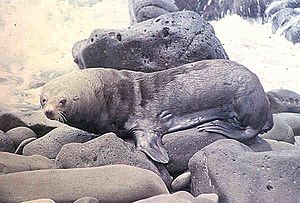
- Guadalupe fur seal (Arctocephalus townsendi) – This is the main place where they have their young.
- Townsend's storm petrel (Hydrobates socorroensis) – This is the only known place where they breed.
- Ainley's storm petrel (Hydrobates cheimomnestes) – This is the only known place where they breed.
- Guadalupe rock wren (Salpinctes obsoletus guadalupensis) – Found only here.
- Guadalupe house finch (Haemorhous mexicanus amplus) – Found only here.
- Guadalupe pipefish (Syngnathus insulae) – Found only here.
- Guadalupe junco (Junco insularis) – Found only here.
- Guadalupe caracara (Caracara lutosa) – Found only here, but now extinct.
- Guadalupe Bewick's wren (Thryomanes bewickii brevicauda) – Found only here, possibly extinct.
- Unique spiders:
- Habronattus gigas
- Herpyllus giganteus
- Kibramoa isolata
- Sergiolus guadalupensis
Plants:
- Baeriopsis guadalupensis – Almost only found here.
- Brahea edulis (Guadalupe palm) – Mostly found only here.
- Camissonia guadalupensis ssp. guadalupensis – Found only here.
- Castilleja fruticosa – Found only here.
- Cistanthe guadalupensis – Found only here.
- Hesperocyparis guadalupensis (Guadalupe cypress) – Found only here.
- Cryptantha foliosa – Found only here.
- Deinandra frutescens – Found only here.
- Deinandra greeneana ssp. greeneana – Found only here.
- Deinandra palmeri – Found only here.
- Dudleya guadalupensis – Found only here.
- Dudleya virens ssp. extima – Found only here.
- Eriogonum zapatoense – Found only here.
- Erysimum moranii – Found only here.
- Eschscholzia elegans – Almost only found here.
- Eschscholzia palmeri – Found only here.
- Galium angulosum – Found only here.
- Githopsis diffusa var. guadalupensis – Found only here.
- Hemizonia frutescens – Found only here.
- Hemizonia greeneana ssp. greeneana – Found only here.
- Hemizonia palmeri – Found only here.
- Heteromeles arbutifolia var. macrocarpa – Likely found only here.
- Lavatera lindsayi – Found only here.
- Lupinus niveus – Found only here.
- Marah guadalupensis – Almost or only found here.
- Perityle incana – Found only here.
- Phacelia phyllomanica – Found only here.
- Pinus radiata var. binata (Guadalupe Monterey pine) – Almost or only found here.
- Satureja palmeri – Found only here; rediscovered recently.
- Senecio palmeri – Found only here.
- Sphaeralcea palmeri – Found only here.
- Sphaeralcea sulphurea – Found only here.
- Stephanomeria guadalupensis – Found only here.
- Triteleia guadalupensis – Found only here.
Animals and Plants That Have Disappeared
Many animals and plants have become extinct on Guadalupe Island. This happened because the wild goats destroyed their homes. This also made the unique animals more vulnerable to wild cats and bad weather.
About 5 or 6 types of birds have disappeared:
- Guadalupe Bewick's wren (Thryomanes bewickii brevicauda), late 1890s
- Guadalupe spotted towhee (Pipilo maculatus consobrinus), late 1890s
- Guadalupe caracara (Caracara lutosa), 1906 – This bird was intentionally made extinct by people. This was because it sometimes ate young goats.
- Guadalupe red-shafted flicker (Colaptes auratus rufipileus), 1906 – Other flickers later came back to the island from the mainland.
- Guadalupe storm petrel (Hydrobates macrodactyla), 1910s
- Guadalupe ruby-crowned kinglet (Corthylio calendula obscurus) – This bird is very close to disappearing, if it still exists.
Plants that are now extinct from Guadalupe Island are:
- Castilleja guadalupensis
- Hesperelaea palmeri
- Pogogyne tenuiflora
And one other plant species that is not fully identified.
See also
 In Spanish: Isla Guadalupe para niños
In Spanish: Isla Guadalupe para niños


